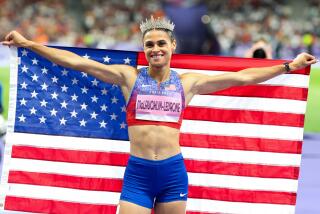A Fast Start for Atlanta
- Share via
ATLANTA — In a sport devoted to numbers, the debate among track and field aficionados Saturday revolved around which was the most impressive number to emerge from the meet to inaugurate the Centennial Olympic Stadium.
Was it the 3 minutes 50.86 seconds run by Algeria’s Noureddine Morceli, the fastest mile ever outdoors in the United States, beating the great Jim Ryun’s 3:51.1 in 1967? Or was it the 19 feet 9 inches in the pole vault by Ukraine’s Sergei Bubka, the highest ever in the United States, beating the great Bubka’s 19-8 1/4 in 1992?
Or was it the 19th 200-meters victory in a row by Michael Johnson in 19.83, the fastest time in the world this year? He could not have been a step slower and beaten Michael Marsh, who finished second in 19.88.
Or was it 35? That is the age that Carl Lewis will turn in six weeks. But on this day all he did was turn back the clock as he ran a slightly wind-aided 9.94 in the 100 to finish behind Dennis Mitchell (9.93) and ahead of Canadian world champion Donovan Bailey (9.97). Jon Drummond also broke 10 seconds (9.98).
Only in Europe are meets so routinely superb that they are actually titled World Class, as in the Weltklasses of Zurich, Switzerland, and Cologne, Germany. The first, and perhaps last, Atlanta Grand Prix was their equal in everything but name.
With 51 Olympic and world championship medalists in the field, outdoor world bests for this year were recorded in seven events. Besides Morceli, Johnson and Bubka, pacesetters were Jackie Joyner-Kersee in the long jump (23-7 1/2), Gwen Torrence in the 100 (10.85), Sandra Farmer-Patrick in the 400-meter hurdles (54.17) and Butch Reynolds in the 400 (44.33).
The athletes even outclassed the dignitaries, which was not as easy as it sounds. It took seven of them, including Vice President Al Gore, International Olympic Committee President Juan Antonio Samaranch and former United Nations Ambassador Andrew Young, to dedicate the $232-million, 83,100-seat stadium in an hourlong ceremony at noon.
The stadium will be used for three more meets--next month’s U.S. Olympic meet, the July 19-Aug. 4 Summer Olympics and the subsequent Paralympics--before the Mondo track is unglued and taken to another location in Atlanta. The stadium then will be reduced by more than 30,000 seats and converted into a baseball stadium in time for the start of the 1997 season.
Despite the fact that it looks more like a ballpark than anything Olympian, the track and field world is already grieving its loss because Centennial Olympic Stadium on Saturday seemed like a very good place for a meet. The Braves will be glad to know that there were few errors on opening day.
Most of them had to do more with the people running the show than the facility. With a multitude of statisticians in attendance, it was almost impossible to find one who could count heads. USA Track & Field officials announced attendance at 67,643. Atlanta Committee for the Olympic Games officials announced 43,328. The latter appeared much closer to the truth. Only between 15,000 and 20,000 actually bought tickets. Those presumably were the ones who stayed to the end to see Bubka miss in three attempts at a world-record height of 20-2.
Except for the heat-seeking sprinters, athletes complained about the heat. The air temperature was in the 90s, meaning it was close to 110 degrees on the track. Crossing fingers on both hands, Olympic officials promised that it will not be hotter in July and August.
Everyone talks about the sorry state of track and field in the United States. But no one did anything about it until this meet, when the IAAF, USATF, IOC and ACOG put their pocketbooks together to attract the best field in this country since at least the 1984 Summer Olympics.
“A high-profile practice meet,” Marsh called it.
He was glad it was practice because he failed to break Johnson’s streak, although he appeared as if he might when he came off the curve with a lead. But Marsh felt a twinge in his hamstring, lost his concentration and could not hold off the man who hopes to make Olympic history by becoming the first to double in the 200 and 400.
“I haven’t been in that position coming off the curve in a while,” Johnson said. “That’s when experience kicked in. I just wanted to bide my time and relax down the straight.”
Refusing to panic also was Mitchell’s strategy when he felt Lewis breathing down his neck at 90 meters in the 100. It worked, even though Mitchell was not sure of it until after officials pored for several minutes over photos of the finish.
“I felt like myself,” Lewis said.
With a tail wind of 2.1 meters per second, just over the allowable of 2.0, Lewis still has not run under 10 seconds legally since his 9.86 in 1991. But this race proved to him that he is capable of it--and to everyone else.
“Carl seems to get focused and find added energy in an Olympic year,” Bailey said. “This is his last hurrah. He’s going to be kicking butt.”
More to Read
Go beyond the scoreboard
Get the latest on L.A.'s teams in the daily Sports Report newsletter.
You may occasionally receive promotional content from the Los Angeles Times.






